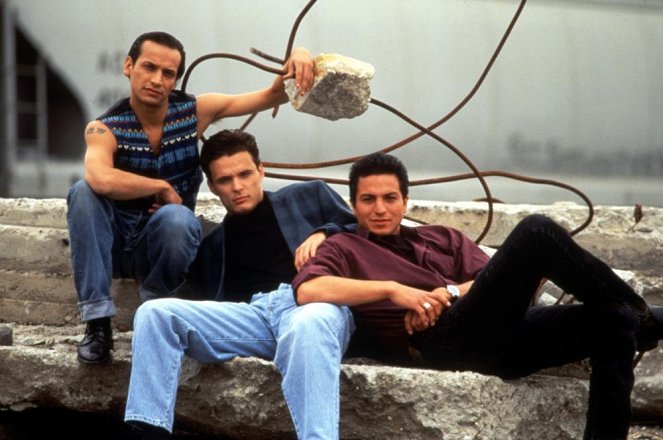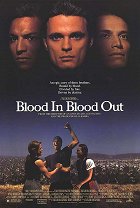Réalisation:
Taylor HackfordPhotographie:
Gabriel BeristainMusique:
Bill ContiActeurs·trices:
Damian Chapa, Jesse Borrego, Benjamin Bratt, Enrique Castillo, Victor Rivers, Delroy Lindo, Tom Towles, Raymond Cruz, Lanny Flaherty (plus)Résumés(1)
Within the rich and colorful Chicano culture of East Los Angeles, three cousins raised as brothers fiercely live by a generations-old tradition of family -- a power stronger than law, a force deeper than friendship. In one life-shattering moment, the trio is torn apart, forcing them to follow three separate paths: one searching for truth in the law, one expressing his passion through art, and one finding power in prison. Yet through it all, family and honor keep their lives intertwined as each strives for survival and power! (texte officiel du distributeur)
(plus)Vidéo (1)
Critiques (1)
I can't remember the last time I watched a movie that was split across multiple CDs. Blood In Blood Out (later rechristened Bound by Honor, for fear that the posters would incite violence, a relevant argument when I recall what it did to me at one time when I kept seeing posters for Men in Hope on every corner) was from the beginning a redheaded stepchild from Buena Vista, i.e. Disney, as it came along at the most inopportune time, the Los Angeles riots, which delayed the film’s release by two years, caused it to flop, and left it waiting in vain to this day for colonization via BluRay or at least some sort of streaming. The question is whether it’s worth it. Blood In, Blood Out does cover the relatively neglected rise of the Latin Mafia in the US South between the 1970s and 1990s, but it runs into a few obstacles. The first is Damian Chapa, whose performance is quite possibly the worst I've ever seen in my life. And I've seen a lot of them! Forget Casper van Dien, Rae Dawn Chong, Neil Breen, Tommy Wiseau, this is beyond. This is all the way down the line next to Lukáš Vaculík in Nudity for Sale or David Švec in Mandragora. The painfully unwitting exploitation of a Mexican gangster who has to make every gesture 180% bigger than it should have been, and I don't understand how after some scenes anyone could have called out from behind the camera "Cut! That’s good, thanks everyone!". The other problem is Hackford's early inability to weave the episodes together, which makes them all feel disconnected from the rest. This is especially noticeable in the monologues, which are meant to bring us up to date on the current situation, and take place as two dudes walking down the stairs in the jail from lunch talk about how their situation in San Quentin is now, in 1982, and what they need to think about for the future. The third issue actually stands above all the others and explains why no one has preferred to pay much attention to the great Latino mafia stories and we are currently seeing mostly films where its microcosm, codes, and ephemeral qualities are dealt with in their consequences and effects on American society and the individual, see The Counselor, Breaking Bad, Sicario, No Country For Old Men, etc. In fact, Cormac McCarthy himself, through The Counselor, concluded his work with a statement about the insurmountable cultural barrier between North America and the rest of it. Blood In, Blood Out proves it – it's a white American take on Latin American gangster structures. Logically, then, it comes across as confused, hysterical, and infantile because it works only from what the writers saw but never understood.
()
Photos (10)
Photo © Hollywood Pictures


